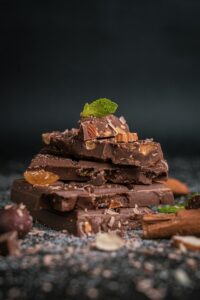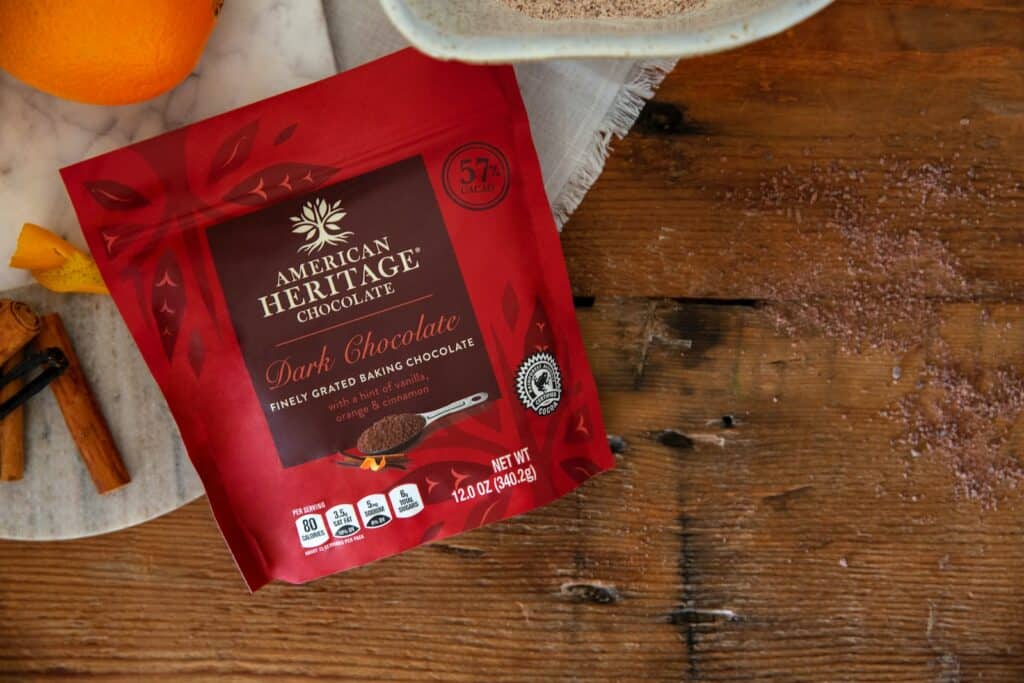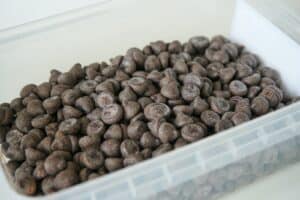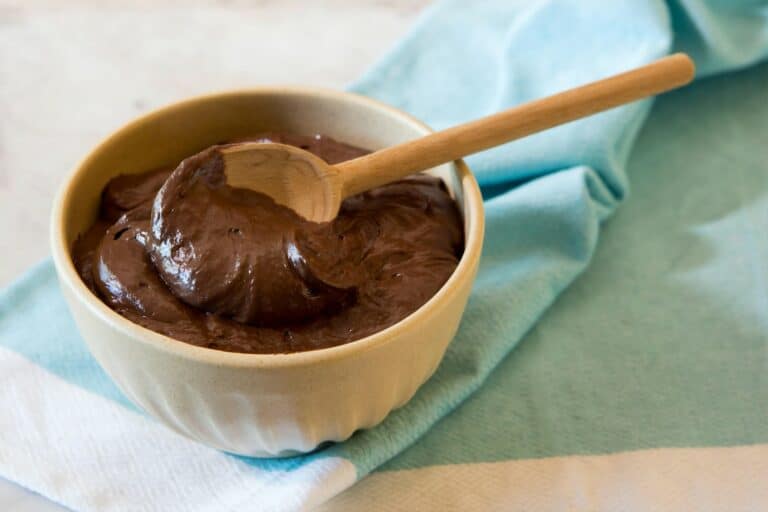Chocolate comes in many forms, shapes, and flavors, and there is a type for every chocolate enthusiast. However, one question that often arises is: can you eat cooking chocolate? In this blog post, we will unravel the mysteries of cooking chocolate, explore the differences between normal chocolate and baking chocolate, take a closer look at the various types of cooking chocolate, and provide insight into whether it is suitable for eating outside of your baking endeavors.
Difference between cooking chocolate and regular chocolate

While both cooking chocolate and regular eating chocolate derive from processed cocoa beans and share some similar ingredients, such as cocoa solids and cocoa butter, there are some key differences that set them apart.
Cacao content: Cooking chocolate typically has a higher cacao content than regular chocolate, which means it has a more intense flavor. This can be expressed as a cocoa percentage on the packaging, with higher percentages indicating a richer, darker chocolate.
Sweetness level: One of the main distinctions between cooking chocolate and normal chocolate is the sugar content. In general, cooking chocolate contains less sugar or, in some cases, virtually no sugar, resulting in a more pronounced, bitter taste. This lack of sweetness helps balance out the flavors in baked goods and other recipes.
Texture: A higher cocoa butter content in cooking chocolate yields a smoother texture–perfect for melting and incorporating into dishes. Regular eating chocolate, on the other hand, is formulated to have a firmer texture that is easy to bite into, thanks to slightly lower levels of cocoa butter and added milk solids.
Other differences in ingredients: Cooking chocolate may contain additives such as soy lecithin to help with emulsification and provide a better texture for baking. Regular chocolate, however, may have more added sugar, milk, and flavorings that contribute to its sweetness and palatability.
Types of cooking chocolate
There are various types of cooking chocolate, each with its unique characteristics:

1. Unsweetened chocolate: Often called baking chocolate, this type of chocolate is made purely from processed cocoa beans and contains no added sugar. It has a dark, bitter flavor and is mostly used in baking recipes where other sweeteners are present.
2. Bittersweet chocolate: This is a dark cooking chocolate made with little or no sugar, which gives it a more pronounced bitter taste. It can be used in a variety of recipes, from chocolate cakes to hot chocolate.
3. Semi-sweet chocolate: Slightly sweeter than bittersweet chocolate, semi-sweet chocolate strikes a balance between bitter and sweet with the addition of some sugar. It’s commonly found in chocolate chip form and used in baked goods like cookies and brownies.
4. Milk chocolate: While not as popular for cooking, some aficionados opt for milk chocolate to add a creamy, sweet taste to their recipes. It’s made with added milk powder or milk solids, resulting in a lighter color and flavor than dark chocolate.
5. White chocolate: Although not technically a true chocolate, white chocolate is made from cocoa butter, sugar, and milk solids, making it a delicious addition to recipes that require a smoother, sweeter flavor.
6. Cocoa powder: Made from cocoa solids with most of the cocoa butter removed, cocoa powder is another essential ingredient in many baking and cooking recipes.
Taste of cooking chocolates
The taste of cooking chocolates can vary greatly depending on the cocoa solids and sugar content. Unsweetened chocolate, with its pure chocolate flavor and virtually no sugar, will have the most pronounced bitter taste. Conversely, milk chocolate will be the sweetest and creamiest, with dark and semi-sweet chocolates falling somewhere in between.
Common uses of cooking chocolate
Cooking chocolate is utilized in various ways to elevate the flavor and richness of recipes and sweet treats:
1. Baking: From chocolate cakes and brownies to cookies and truffles, chocolate is an integral component in countless baking recipes.
2. Sauces and ganache: Melted chocolate is combined with cream or butter to create silky sauces and ganaches that can be used as glazes, fillings, or toppings for desserts like chocolate mousse or eclairs.
3. Chocolate fountains: Hosting a party? Why not impress your guests with a decadent chocolate fountain filled with melted semi-sweet or milk chocolate for dipping fruits, marshmallows, and other sweet treats.
Can you eat cooking chocolate?

The answer really depends on several factors, including personal taste preferences, health considerations, and budget.
Pros of eating cooking chocolate:
1. Intense chocolate flavor: The higher cocoa solids content in cooking chocolate results in a richer chocolate taste, which some might prefer.
2. Lower sugar content: For individuals watching their sugar intake, the lower sugar content in some cooking chocolates, such as unsweetened chocolate, could be a desirable option.
3. Convenience: If you have cooking chocolate on hand for a recipe, it might be tempting to simply enjoy a piece or two rather than buying a separate chocolate bar for snacking.
Cons of eating cooking chocolate:
1. Bitter taste: The lack of sweetness in some cooking chocolates might be off-putting to those with a sweet tooth.
2. Texture: Cooking chocolate is generally not formulated for the same satisfying bite one might expect from a regular chocolate bar.
3. Cost: Depending on the brand and quality, cooking chocolate may be more expensive than regular eating chocolate, which could be a deterrent for some individuals.
Ultimately, determining whether or not to eat cooking chocolate comes down to personal preferences and reasons. If you prefer a more intense cocoa flavor with less sugar, cooking chocolate could be an enjoyable option for you. On the other hand, if you crave the smooth, sweet taste of a traditional chocolate bar, you may want to stick with regular eating chocolate instead.
Alternatives to cooking chocolate for snacking

Looking for a chocolate fix but not sure cooking chocolate is the right choice for you? Here are a few alternatives:
1. Dark chocolate bars: With a range of cocoa percentages available, you can find one that suits your taste buds. Dark chocolate bars can provide the intense chocolate flavor found in cooking chocolate, while still being formulated for enjoyment as a snack.
2. Chocolate chips: More than just for baking, chocolate chips can also be enjoyed as a delicious treat. Opt for dark chocolate, milk chocolate, or even flavored options.
3. Healthier chocolate snacks: There is a wide variety of chocolate-flavored snacks on the market, such as chocolate protein bars or fruit bars coated in a thin layer of chocolate, that can satisfy your cravings without overindulging in added sugars.
Final Thoughts
While cooking chocolate is primarily designed for use in baking and other culinary applications, it can be eaten as a snack, depending on personal taste preferences and certain factors like health considerations and cost. Whether you reach for cooking chocolate or stick with regular eating chocolate, there is no denying that the world of chocolate offers endless possibilities for those who love this rich and diverse treat.
